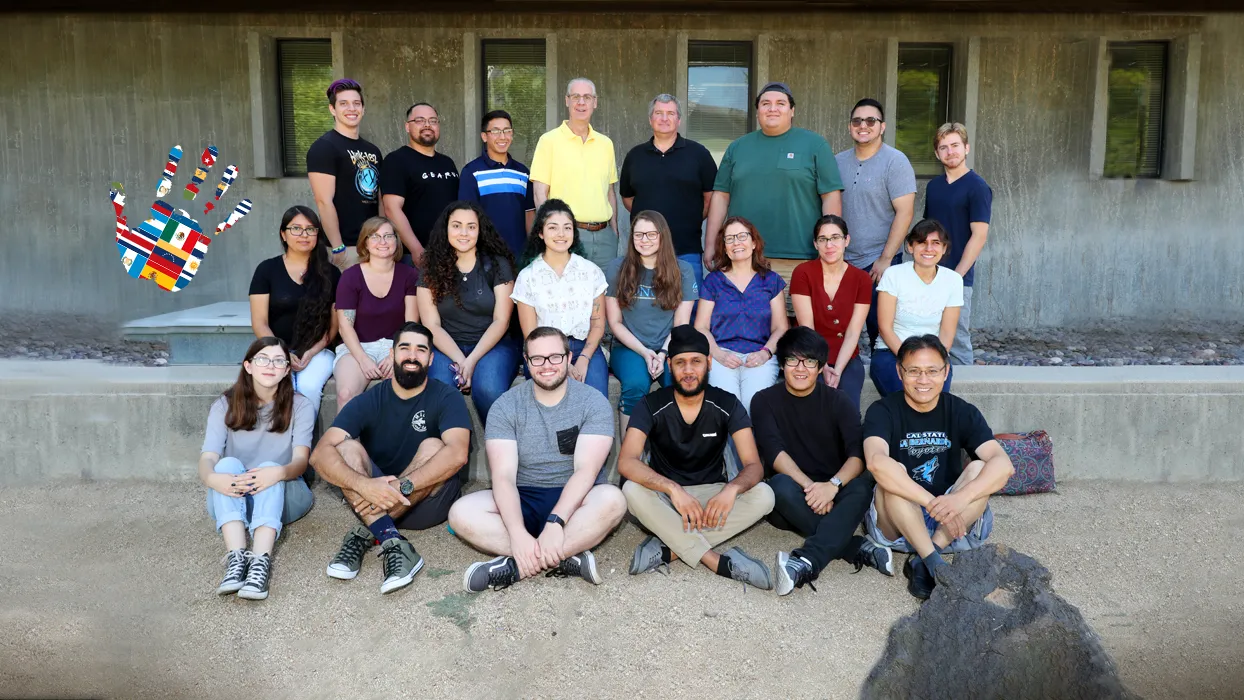Joe Gutierrez Office of Strategic Communication (909) 537-5007 joeg@csusb.edu

Editor’s note: As part of CSUSB’s celebration of Hispanic Heritage Month, the university is showcasing a number of earlier stories highlighting Hispanic and Latino students, alumni, faculty and staff, along with programs and grants for the university’s diverse populations.
This news release was originally published on Aug. 15.
A new $5 million federal grant to the College of Natural Sciences (CNS) strongly positions Cal State San Bernardino as a center for important research in the science of functional materials, providing hands-on research experiences for diverse students.
The funding from the National Science Foundation’s (NSF) Centers of Research Excellence in Science and Technology II (CREST II) program is the second $5 million NSF grant awarded to the college’s Center for Advanced Functional Materials (CAFM).
The grant comes on the heels of several other awards and grants that further extend the college’s capacity for discovery, innovation and student success in science, technology, engineering and mathematics (STEM) fields, and particularly in materials research.
The CREST II grant — one of only five CREST awards announced nationwide so far this year — will strengthen the university’s and college’s research competitiveness as a minority-serving institution. The funds help broaden the institution’s capacity to recruit and retain diverse students pursing STEM degrees and careers, as well as strengthen research collaborations with institutions and local community colleges to help students advance through the academic pipeline.
“I am very proud about the tremendous success of our faculty and our CAFM team in advancing significant research and positively impacting our students,” CNS Dean Sastry G. Pantula said. “CREST II funding provides transformative experiences to our students to discover new frontiers. It is absolutely vital for accelerating and catapulting this momentum and for cultivating a new generation of graduate students, science educators and innovative leaders for our communities and our world.”
“This is a huge feather in our collective caps, and win for the college and university,” said Kimberley Cousins, faculty member and chair of the Department of Chemistry and Biochemistry, who also serves as a principal investigator for the new CREST research grant, and co-principal investigator for the previous award. CAFM research involves faculty and students from the college’s physics, chemistry and biochemistry departments.
CREST grants are vital to the college’s and CSUSB’s commitment to increasing underrepresented student populations in STEM fields. Such grants fund the CAFM’s objectives, which include:
- Advancing the scientific understanding of functional materials, which are materials that respond in predictable ways to the outside influence of electric and/or magnetic fields. These materials could propel the next wave of electronic technologies with the promise of less expensive, more flexible and nontoxic methods to store digital information, create medical sensors and displays and develop new semiconductors, among a myriad of other applications. So far, CAMF has identified two new ferroelectrics and is testing two others.
- Supporting continued research collaborations between CSUSB, the College of the Desert in Palm Desert and Victor Valley College in Victorville — all three minority-serving institutions — and the University of Nebraska-Lincoln’s Materials Research Science and Engineering Center, The State University of New York at Buffalo, and NASA’s Armstrong Flight Research Center, all three eminent research centers.
- Creating opportunities for community college students through internship-like (“winternship”) research enrichment experiences, interdisciplinary research experiences for CSUSB STEM majors, summer research and graduate study, and leveraging of the university’s Upward Bound program — which works to help disadvantaged, low-income, and first-generation students graduate from high school and enroll in and graduate from CSUSB — as a recruiting mechanism.
- The development of a new materials science master’s degree program.
“The new funding elevates CSUSB’s stature as an institution that can produce important research in the science of functional materials,” Cousins said. “New technological advances in instrumentation, aviation, computing and other fields require the development of new functional materials.”
The CAFM team includes Doug Smith and Renwu Zhang, professor and associate professor, respectively, from the Department of Chemistry and Biochemistry; and Paul Dixon, Sara Callori and Tim Usher, department chair, assistant professor, and professor/CAFM director, respectively, from the Department of Physics.
The scientific breakthroughs of today increasingly involve working across disciplines and collaborating with other institutions, Cousins said. Pointing to examples, CAFM researchers will soon embark on new collaborations with Cal Poly Pomona involving single-crystal X-ray diffraction, and with the National Institutes of Science and Technology in work involving neutron scattering.
“For our faculty and students to succeed, we need expertise from chemistry, physics, engineering and related disciplines, as well as faculty and student input and shared instrumentation and facilities from external collaborators,” Cousins said.
Evaluators of CAFM determined it has served over the past five years a total of 110 CSUSB students, 138 community college students, and 25 high school students, with most undergraduates identified as male (65 percent), Hispanic (57 percent), and first-generation (53 percent). Out of 53 CAFM graduates, 29 are enrolled in a STEM program at graduate schools across the country. CAFM students also graduate at higher rates than the College of Natural Sciences and the university overall.
“Research opportunities supported by CREST funding are contributing factors to CSUSB being ranked as one of the nation’s leading universities in awarding degrees in the physical sciences to Hispanics,” Cousins said.
CREST support has also been leveraged to secure additional sources of funding, such as two grants from the NSF’s Major Research Instrumentation (MRI) Program. One approximately $250,000 grant was used to purchase a magnetron sputter deposition system, which uses magnetic fields in a special thin-film coating process used to develop new materials. Another MRI grant was used to acquire an X-ray powder diffraction system that is used to identify unknown crystalline and other materials.
“We design materials for tomorrow’s technologies,” Cousins said.